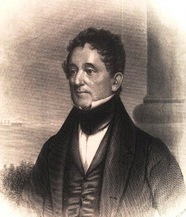Hezekiah Pierrepont
| Hezekiah Pierrepont | |
|---|---|

engraved portrait by John Chester Buttre
|
|
| Born | 1768 New Haven, Connecticut |
| Died | 1838, aged c.70 Brooklyn, New York |
| Nationality | United States |
| Occupation | merchant, adventurer, farmer, landowner, developer |
| Known for | "founding" of Brooklyn Heights |
Hezekiah Beers Pierrepont (1768-1838) was a merchant, farmer, landowner and land developer in Brooklyn and New York state. He restored the spelling of the family surname from "Pierpont" to "Pierrepont", its original French spelling.
Pierrepont was born in New Haven, Connecticut in 1768 of a long-established New England family – his grandfather was one of the founders of Yale University.
After making some money by speculating on the national debt, in 1793 Pierrepont, at the age of 25, launched a career as a merchant-adventurer. He relocated to Paris and, with his cousin, began to import goods to France, later expanding the company's scope to India and China. The business came to an end when his ship, the Confederacy, was captured in the China Sea by privateers in 1797, while he was onbaord. Having made a small fortune, he was now bankrupt, and returned to the United States. He settled in Brooklyn in 1802.
Pierrepont married Anna Marie Constable, from a prominent New York merchant and landowning family, and through a wedding present from her father, William Constable, of a half a million acres of land, became a major property owner in upstate New York; the town of Pierrepont, New York is named after him. He bought 60 acres (24 ha) – part of the Livingston estate, plus the Benson, De Bevoise and Remsen farms – on what was then called "Clover Hill", now Brooklyn Heights, and built a mansion there. Pierrepont purchased and expanded Philip Livingston's gin distillery on the East River at what is now Joralemon Street, where he produced Anchor Gin. Although very popular, competition from other distillers cut into his profits, and he left the business in 1819.
Wishing to sub-divide and develop his property, Pierrepont realized the need for regularly scheduled ferry service across the East River, and to this end he became a prominent investor in Robert Fulton's New York and Brooklyn Steam Ferry Boat Company, using his influence on Fulton's behalf; he eventually became a part owner and a director of the company. Fulton's ferry began running in 1814, and Brooklyn received a charter as a village from the state of New York in 1816, thanks to the influence of Pierrepont and other prominent landowners. The city then prepared for the establishment of a street grid, although there were competing plans for the size of the lots. John and Jacob Hicks, who also owned property on Brooklyn Heights, north of Pierrepont's, favored smaller lots, as they were pitching their land to tradesman and artisans already living in Brooklyn, not attempting to lure merchants and bankers from Manhattan as Pierrepont was. To counter the Hickses' proposal, Pierrepont hired a surveyor and submitted an alternative. In the end, the Hickses' plan was adopted north of Clark Street, and Pierrepont's, featuring 25 by 100 foot (8 by 30 meter) lots, south of it.
...
Wikipedia
